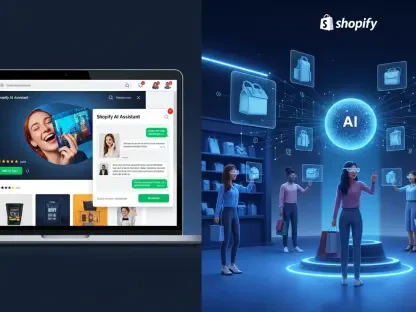The prospect of accessing advanced generative AI and large language models through a simple phone call is no longer a futuristic concept but a present reality. OpenAI’s recent release of 1-800-CHATGPT exemplifies this paradigm shift, making artificial intelligence not just an elite tool for tech-savvy individuals but a resource available to anyone with access to a conventional phone line. This innovative approach transcends the need for an internet connection or a smartphone, thereby expanding the horizon of who can benefit from AI technology. As a result, this inclusive model is exerting pressure on other AI developers to follow suit, significantly increasing AI accessibility on a global scale.
Understanding Generative AI via Phone Calls
Generative AI’s newfound accessibility through phone lines marks a pivotal moment in technological inclusivity. Capable of performing a variety of tasks such as speaking, writing, and comprehending human language, these AI systems traditionally required access to web platforms or smartphones. However, OpenAI has broken this mold with the introduction of 1-800-CHATGPT. This toll-free number allows users to engage with ChatGPT, the leading AI conversational agent, simply by making a phone call. The elimination of digital barriers for those without smartphones or reliable internet connections is significant, enabling broader segments of the population to benefit from AI advancements.
OpenAI’s system offers up to 15 minutes of free phone-based usage each month without requiring users to register. This usage is monitored through the phone numbers, ensuring easy but controlled access. Initially, this service is available exclusively for U.S.-based numbers. However, an alternative access method is also available through text messages on platforms like WhatsApp, further expanding the reach of generative AI to potentially underserved and underconnected populations. This approach stands as a testament to OpenAI’s commitment to breaking down accessibility barriers, democratizing AI participation across various demographics.
Process Mechanics
The traditional method of utilizing generative AI often involves web or smartphone interfaces where users input text prompts and receive text-based responses. In contrast, the phone-based system leverages voice-to-text conversion mechanisms to function effectively. Upon dialing the number, users are greeted by the AI, and conversations are conducted entirely through spoken words, facilitated by the internal voice-to-text and text-to-voice conversions. The AI’s responses are read aloud, ensuring an uninterrupted and seamless interaction until the call concludes or the allotted time limit is reached.
However, this revolutionary approach is not without its challenges. For example, incorrect dialing due to the large user base can lead to significant numbers of misdialed calls, causing confusion and frustration. Furthermore, the risk of scams is prevalent, as malicious actors might create similar-sounding numbers to exploit this phenomenon, attempting to steal personal information or trick users into making unnecessary purchases. Errors in voice recognition, particularly in cases involving accents, background noise, or issues with voice clarity, could also lead to misunderstandings and user frustration. Additionally, interruptions in the phone network or reception issues can prematurely drop calls, causing irritation and potentially hindering important communications.
Privacy and Data Security
The use of voice data brings with it substantial privacy concerns. User utterances during phone-based AI interactions could be stored and used by developers to enhance the AI’s services. This raises significant questions about how personal data is handled and whether users are sufficiently informed about its potential misuse. For instance, stored voice data might be employed to create synthetic voices or further train AI systems without obtaining users’ explicit consent, which could lead to ethical and legal dilemmas.
Tracking users by their phone numbers presents another layer of concern. These numbers could potentially be cross-referenced with other databases, allowing for identification and profiling of users, thereby raising privacy issues. To mitigate these challenges, it is essential for AI developers to establish clear and transparent licensing terms regarding the utilization of voice data, ensuring users are well-informed and protected against unauthorized usage. Instituting robust data privacy policies is paramount to instilling user trust and maintaining ethical standards in AI deployment.
Accessibility and Democratization of AI
The advent of phone-based AI access paves the way for unprecedented democratization of technology. By eliminating the need for internet access or smartphones, millions of individuals who were previously excluded from AI benefits due to digital barriers can now participate. This initiative marks a significant advance towards equitable AI access, striving to bridge the digital divide that often leaves less connected populations at a disadvantage. This democratization aligns with the broader objective of making cutting-edge technology inclusive and accessible to all, regardless of socioeconomic status or geographical limitations.
The potential for generative AI to revolutionize everyday lives is immense, particularly for communities that lack robust digital infrastructure. Individuals in remote or underserved areas can now seek information, entertain educational pursuits, or receive mental health support through AI, all via a simple phone call. This shift not only empowers individuals but also drives the inclusive growth of technological advancements, ensuring no one is left behind in the rapidly evolving digital era.
Key Trends and Future Prospects
The landscape of AI accessibility is undergoing a remarkable transformation, emphasizing inclusivity and democratization. Expanding AI access to regions with limited infrastructure is a clear indication of the growing emphasis on inclusive technology. The shift towards facilitating AI interactions through basic mobile and landline phones predicts a future where individuals worldwide, irrespective of their familiarity with advanced gadgets or financial capacity to afford them, will have access to AI resources.
This trend underscores the necessity for simple, user-friendly interfaces that demand no downloads, logins, or advanced technical skills, enabling a broader user base to engage seamlessly with AI. As generative AI continues to evolve, we can anticipate more varied and user-friendly methods of delivery and interaction, further broadening the scope and potential of AI technologies. This evolution will likely make AI tools more accessible, useful, and integral to daily life, fundamentally altering the way we interact with technology.
Ethical Considerations and Policy Implications
While the inclusivity of AI technology is a milestone worth celebrating, it is imperative to address the accompanying ethical considerations. The utilization of AI for unofficial mental health support, for example, poses significant ethical dilemmas. Users might replace professional advice with AI interactions, potentially leading to adverse consequences. Ensuring that AI use does not substitute professional mental health services is essential for safeguarding user well-being.
Additionally, compliance with stringent data privacy laws is crucial to prevent unauthorized usage of sensitive data, such as voice recordings and personal identifiers. Developers must navigate these legal frameworks diligently to ensure the responsible and ethical deployment of AI technologies. Furthermore, the necessity for regulatory oversight cannot be overstated; it is paramount for emerging AI practices to be monitored and regulated to prevent exploitation or harm and to ensure that advancements serve the public good responsibly.
Conclusion
The idea of using advanced generative AI and large language models with just a phone call has moved from science fiction to reality. OpenAI’s latest release, 1-800-CHATGPT, captures this shift, showing that artificial intelligence is no longer just for tech experts. Instead, AI is becoming a tool accessible to anyone with a regular phone line. What’s groundbreaking is that this method removes the need for an internet connection or even a smartphone, widening the scope of who can utilize AI technology.
This inclusive strategy has far-reaching implications, pushing other AI developers to adopt similar approaches. It’s not only about technological advancement but also about democratizing access to AI tools, thereby making AI more universally accessible. Imagine someone in a remote area with no internet access easily contacting an AI for information, assistance, or even companionship. This ability can enrich lives, provide educational opportunities, and solve problems in ways that weren’t previously possible.
As more companies recognize the potential and necessity of such inclusive access, we can expect a surge in AI-driven solutions tailored to meet the needs of a broader audience. Consequently, AI technology is set to become a staple in everyday life, impacting sectors from education to healthcare, and beyond. By bridging the gap between advanced technology and everyday users, 1-800-CHATGPT is setting a new standard for AI accessibility on a global scale.









